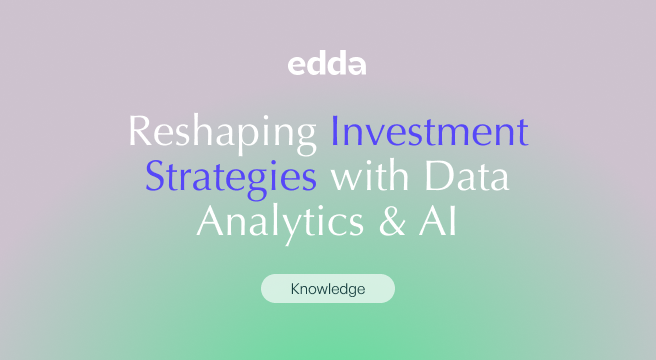AI and data analytics are reshaping investment strategies. Yet, the path to a fully data-driven model is littered with challenges, most notably in data quality and the need for specialized technical skills.
This article aims to unpack the transition, offering clear insights and practical strategies for investment firms ready to embrace this change. We’ll explore the current landscape, identify common hurdles, and provide actionable steps to integrate data-driven decision-making into your investment process.
In addition, discover how Edda, the best CRM for venture capital (VC) and private equity (PE) is changing the game when it comes to CRM data quality and management.
The Current State of Data-Driven Venture Capital
The integration of artificial intelligence (AI) and data analytics into the core of investment decision-making processes promises to arm investors with unprecedented insights, enabling a level of precision in decision-making previously unseen.
Tools like GPT-4, for instance, offer deep, nuanced market analyses, while data visualization technologies provide clear, actionable insights into complex datasets. These advancements facilitate a more nuanced understanding of market dynamics, startup viability, and potential investment pitfalls.
Despite the clear advantages, the path to integrating these advanced tools is not straightforward. Many firms find themselves grappling with the foundational requirement of high-quality, relevant data. The challenge is twofold: not only must the data be accurate and comprehensive, but it must also be actionable, serving the specific needs of the firm’s investment strategy.
Furthermore, the shift to a data-driven model demands substantial investment in technical talent, including data scientists and engineers, roles that were not traditionally part of venture capital firms’ staffing models.
The Promise vs. Reality
The theoretical benefits of a data-driven approach are compelling, offering the potential for more targeted investments, reduced risk, and optimized portfolio performance. However, the practical application of these strategies often reveals a gap between promise and reality.
Firms may encounter obstacles in the effective implementation and integration of data-driven methods, ranging from technical challenges in data processing and analysis to cultural resistance within traditionally intuition-driven organizations.
Characteristics of Data-Driven VC Firms
Distinguishing traits have emerged among firms that successfully leverage a data-driven model. These characteristics not only reflect their adeptness at employing advanced technologies but also underscore a strategic, holistic embrace of data across their operations.
Organizational Structure & Talent
Central to the efficacy of data-driven firms is their human capital. Typically, such entities boast dedicated teams of data scientists and engineers who craft, refine, and maintain the data infrastructure.
These professionals are tasked with mining insights from complex datasets and translating these findings into actionable strategies that inform investment decisions. The commitment to building such specialized teams prioritizes data science and engineering as core competencies within the modern VC firm.
To maintain a competitive edge, these firms prioritize ongoing professional development, ensuring their staff remain at the forefront of data science methodologies and technological advancements. This focus on expertise ensures the firm is equipped to handle current data challenges but is also poised to adapt to future innovations in data analysis and machine learning.
Investment in Data Infrastructure
The foundation of a data-driven approach lies in dynamic data infrastructure including data storage solutions capable of securely housing vast amounts of information, and sophisticated data processing that analyzes the information.
Additionally, state-of-the-art analytics platforms extract actionable insights from the data to support informed investment decision-making.
Given the sensitive nature of the information handled, these firms also place a premium on cybersecurity and data privacy, ensuring the integrity and confidentiality of their data assets. T
Data-Centric Culture
The most transformative characteristic of data-driven VC firms is a data-centric culture. In these environments, data is revered as a crucial asset, integral to the decision-making process. This cultural shift complements traditional investment expertise with a rigorous, analytical approach to evaluating opportunities.
Fostering a data-centric culture involves redefining metrics of success, promoting an ethos of experimentation, and creating an environment where data-informed decisions are celebrated. This mentality boosts firms’ strategic agility and embeds a continuous learning mindset within the organization.
Strategic Data Acquisition & Partnerships
The ability to procure relevant, high-quality data is a defining trait of successful data-driven firms. This involves strategic partnerships with data providers, collaborative data-sharing arrangements with portfolio companies, and investments in proprietary data collection efforts.
The discernment to identify and leverage data sources that offer meaningful, actionable insights is a critical advantage for these firms, enabling a deeper understanding of market trends, startup potential, and investment risks.
Agile Methodologies & Continuous Iteration
Embracing agile methodologies allows data-driven VC firms to respond swiftly to new information and shifts. This adaptability is made possible by the commitment to continuous iteration, where investment strategies and data models are regularly refined based on emerging data and feedback loops.
This emphasis on agility and iteration fosters an environment of perpetual learning and evolution, with data acting as a catalyst for strategic innovation and refinement.
Crafting a Data-Driven Strategy
The journey toward becoming a data-driven venture capital firm involves more than just collecting vast amounts of data; it requires a well-thought-out strategy that aligns data acquisition and analysis with the firm’s investment goals.
Here’s how to implement a data-driven strategy in your firm:
- Define Data Objectives: The first step in crafting a data-driven strategy is to clearly define what you aim to achieve with data. Objectives can range from improving deal sourcing and due diligence to enhancing portfolio management and exit strategies.
- Identify Key Data Sources: With objectives in place, the next step is to identify data sources that can provide the insights required to achieve these goals. This involves a mix of public and proprietary data, ranging from financial statements and market reports to social media analytics and customer feedback. The challenge lies not only in sourcing this data but also in ensuring its quality and relevance to your investment thesis.
- Building or Enhancing Data Infrastructure: To effectively manage and analyze the identified data, infrastructure is essential. This may involve upgrading existing systems or building new capabilities from scratch. Key components include data storage solutions, analytics platforms, and AI tools for advanced analysis. Security and compliance are also critical, given the sensitive nature of the data handled.
- Developing Analytical Models: With the infrastructure in place, the next step is to develop analytical models that can transform raw data into actionable insights. These models can range from simple statistical analyses to complex machine-learning algorithms. The goal is to identify patterns, trends, and anomalies that can inform investment decisions.
- Integrating Data into Decision-Making: The ultimate test of a data-driven strategy is its integration into the firm’s decision-making processes. This requires not only the right tools and technologies but also a cultural shift within the organization. Stakeholders at all levels must be trained to understand and trust data-driven insights, and processes must be adapted to incorporate these insights into everyday decisions.
- Continuous Learning and Iteration: A data-driven strategy is never static. The market environment, available data, and analytical tools are constantly evolving, and so must your strategy. This requires a commitment to continuous learning, regular review of objectives and outcomes, and a willingness to adapt and iterate on your approach.
By following these steps, venture capital firms can develop a comprehensive data-driven strategy that aligns with their investment goals and enhances their decision-making capabilities. The key is to start small, focusing on achievable objectives, and gradually expand the scope as the firm’s data capabilities mature.
Leveraging Tools & Datasets
In the quest to become data-driven, firms must judiciously select and utilize tools and datasets that align with their strategic objectives.
The market is replete with an array of data tools designed to cater to various aspects of the investment cycle. The selection process should be guided by the firm’s specific needs, ranging from deal sourcing and market analysis to portfolio management and performance tracking.
Key considerations include the tool’s compatibility with existing systems, ease of use, scalability, and the quality of support provided. Examples of such tools include CRM platforms with advanced analytics, financial modeling software, and AI-powered market trend analysis tools.
Effective Use of Datasets
Datasets form the lifeblood of a data-driven strategy. Firms must focus on acquiring datasets that offer deep, actionable insights relevant to their investment thesis. This could include industry-specific datasets, consumer behavior data, and competitive intelligence, among others. The challenge lies in ensuring its integrity, relevance, and compliance with data protection regulations. Firms should establish stringent criteria for dataset selection, emphasizing quality, breadth, and depth of information.
Integration with Internal Data
To maximize the value of external tools and datasets, they should be seamlessly integrated with the firm’s internal data. This integration enables a holistic view of the investment landscape, combining external market insights with internal assessments of portfolio companies. Technologies such as data integration platforms and APIs play a crucial role in this process, ensuring smooth data flow and interoperability between systems.
Advanced Analytics & AI
The power of data is fully unlocked when analyzed using advanced analytical techniques and AI. Machine learning models, for instance, can identify patterns and trends that might not be apparent through traditional analysis. Natural language processing can extract insights from unstructured data such as news articles or social media posts. The key is to develop or adopt models that are tailored to the firm’s specific analytical needs and investment focus.
Edda’s Dealflow CRM: Empowering Data-Driven Venture Capital
Edda’s venture capital CRM platform is a game-changer for venture capital firms aiming to harness the power of data analytics and AI in their investment strategies. By merging relationship management with comprehensive deal flow and portfolio data, Edda transforms the investment process into a data-driven ecosystem.
Edda’s CRM simplifies data management and enriches relationship intelligence, uncovering hidden opportunities within the network. Its real-time analytics and updates keep stakeholders aligned, making it an essential tool for firms committed to a data-informed investment approach.
Ready to revolutionize your venture capital firm’s approach with data-driven decision-making? Explore Edda’s private equity CRM platform today and embark on a journey towards enhanced insights, streamlined operations, and superior investment outcomes.









